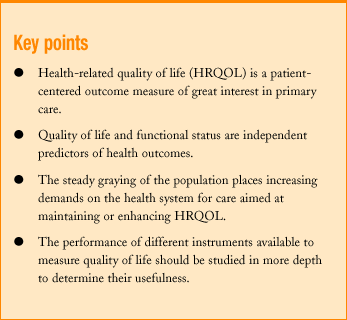The measurement of health and health-related quality of life (HRQOL) is increasingly important for estimating the outcomes of health care programs and interventions. The use of such measures has increased exponentially, together with that of indicators of satisfaction, as part of what may be called patient-centered measures.1
Guyatt defined HRQOL as a concept that attempts to measure an individual´s subjective opinion regarding his or her own health in physical, psychological and social dimensions. Strategies for total quality in health care systems lay considerable emphasis on the results obtained in terms of quality of life, as this is one of the outcome variables that makes it possible to analyze the effectiveness of clinical interventions (at the micromanagement and clinical management level) and plan health services (at the macro- and middle-management level).
In Spain, as in other European countries, the population is graying. Technological advances are making it possible to provide solutions to health problems that would previously have been fatal, and thus increase life expectancies, now among the highest in the world. This demographic transformation has been accompanied by substantial changes in social structures. Family disintegration, higher employment rates among women, and other factors, are creating a situation in which loneliness and lack of social support are often major components of daily life for older persons. This has important repercussions on their quality of life, and on their capacity to cope with self-care.2 These demographic and social changes lead to the increasing use of health resources particularly primary care by this population.
At the same time, a change in people´s expectations regarding their level of health is evident. Health he best health possible has become a product in itself, and a right demanded by all citizens. We are currently able to minimize the symptoms of chronic diseases, and to offer solutions to degenerative diseases (valve replacements, artificial joints) up to very old ages, thus guaranteeing autonomy and a degree of quality of life that make these problems bearable. This trend generates expectations for greater HRQOL in the population, which the primary care professional must satisfy.
Self-perceived quality of life involves factors such as the individual´s values and beliefs, and his or her previous life experiences, together with limitations in the ability to perform daily life activities. This is therefore a complex variable of great bearing on a person´s health status. We could say that what is important is not so much «being well» is as «feeling well.»
Primary care professionals need knowledge about the quality of life in the population they care for. This will allow them to plan responses to the needs that arise, and to be in a position to evaluate the impact of whatever actions are taken. Furthermore, it has been shown that functional status and perceived quality of life are independent predictors of health outcomes.3
Many instruments are now available to measure HRQOL, and their validity, reliability and sensitivity to change (the main characteristics of a suitable instrument)3 have been documented. However, there remains considerable ignorance regarding how HRQOL is related with other patient-centered variables such as perceived satisfaction with health care, and regarding the relationships between different dimensions of HRQOL. Also needed is more knowledge of how these dimensions are related to individuals´ preferences and values.
In epidemiological studies these instruments are used to determine HRQOL for a specific population, to analyze differences in quality of life between different population groups, or to follow changes in a specific group with time and after health interventions. The present study is an important contribution to this field. It was carried out in a representative sample of an urban population older than 65 years, and the response rate better than 66% was sufficient given the complexity of this type of study. The study was based on the simultaneous use of three instruments [the Nottingham Health Profile, the EuroQol quality of life instrument, and the activities of daily life domain of the Older Americans Resources and Services-Multidimensional Functional Assessment Questionnaire (OARS-MFAQ) for functional capacity], an approach intended to provide as complete a view as possible of the multifactorial variable in question. The researchers also analyzed other variables that influence HRQOL, such as physical health, mental health, social and family support, economic resources and socioeconomic factors. This makes the study a very thorough approach to the determination of quality of life in the study population. The authors´ initial report, sure to be followed by other articles, presents descriptive data and does not attempt to analyze the relationships between the different dimensions in depth.
The results show an inverse relationship between age and quality of life, with larger proportions of persons older than 80 years reporting health and daily living problems as identified with the Nottingham Health Profile and the EuroQol instrument. Nevertheless, self-perceived quality of life did not differ between age groups. Women reported worse quality of life indicators, and their self-perceived quality of life was also worse. It would be helpful to see the results of further analyses of these variables once other factors that can modify perceived health (such as level of education, social and family support, etc.) have been controlled for.
The authors draw attention to a potentially useful approach to data analysis, i.e., comparing the performance of different instruments used to study HRQOL in the over-65 population. This analysis will provide information that will allow us to better understand the properties and limitations of each instrument, and with this information, clinicians and researchers will be able to decide more efficiently which instrument is most useful in primary care.









